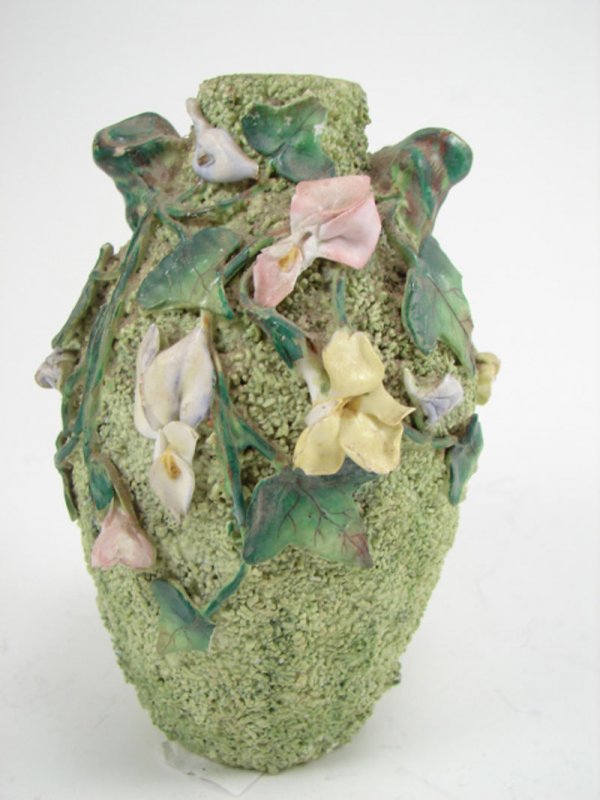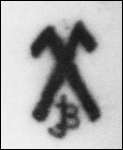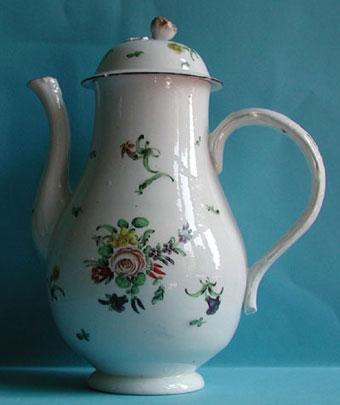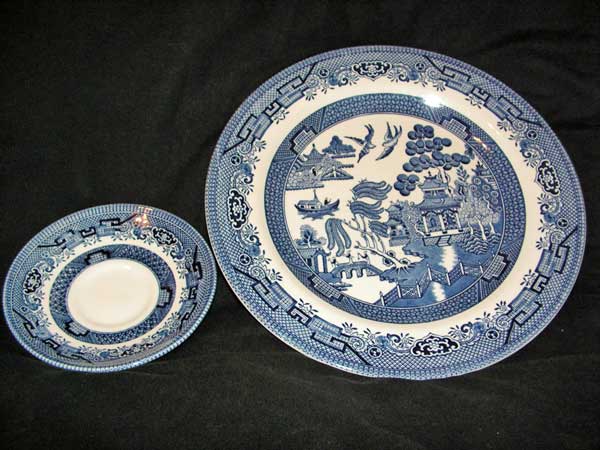Location and period of operation:
Samuel Bevington (& Son)
- Hanley
- 1835
- 1863
He established the Swan Works in Elm Street (now Ratton Street) as a Parian works.
The “& Son” was his son John Bevington who joined the business as a partner of the Elm Street Works c.1856 – he also carried on the works after his fathers retirement and death in 1863.
Samuel Bevington was variously described as ‘artist’, ‘China figure maker’, ‘toy and ornament’ manufacturer and ‘gilder, lusterer and enameller’.
In the trade directories he was recorded as “Samuel Bevington”; Samuel Bevington & Son” and “Bevington & Son”
Samuel Bevington operated three works:
- Swan Works, Elm Street, Hanley 1835-1863 (John Bevington continued these works after his fathers death in 1863)
- Marsh Street, Hanley c.1846-1863
- 10&12 Brunswick Street, Hanley c.1851-1863
BEVINGTON, Samuel, [born c.1808 died 1863] pottery decorator and manufacturer, Hanley, Stoke-on-Trent
| father: Richard Bevington | mother: Hannah Glass |
| Samuel Bevington | wife: Eliza Barlow |
| sons: Richard, Ambrose, John, Henry, Samuel, James, Thomas daughters: Ann | |
| 1808 | Samuel Bevington was baptised at Shelton, Stoke-on-Trent on 8th May 1808. |
| 1835 | He established the Swan Pottery Works in Elm Street (now Ratton Street) |
| 1842 | Samuel Bevington was an active supporter of the chartist movement. He helped the chartist leader, Thomas Cooper, to slip through the police/soldier cordon set up after the riots of 15-16 August 1842. |
| 1848 | Samuel Bevington, together with Edward Sale, attended a Chartist Convention in London on the 4th April 1848 as representatives of the “Staffordshire Potteries”, |
| 1851 | In the 1851 census (see below) Samuel Bevington was recorded as living at 33 Brunswick Street ( – see map below) and described as a China Painter and Guilder. |
| 1855 | Samuel Bevington was a signatory to the trust establishing the “Royal Pottery Theatre” (see below) – the theatre was in Brunswick Street, which was where Samuel’s home was. |
| 1857 | In August and again in October 1857 Samuel made unsuccessful attempts to gain election to the Hanley Council. |
| 1861 | In the 1861 census (see below) he was described as a China & earthenware manufacturer employing 44 hands |
| 1863 | Samuel Bevington died on 8th November 1863 and was buried in Hanley cemetery. |
James Bevington
- Hanley
- 1880
- 1884
James Bevington – son of Samuel Bevington . Manufacturer of earthenware & Rockingham Ware. From c.1863-76 James was in partnership with his brother Thomas Bevington as J & T Bevington
He operated three works:
- Burton Place, New Street, Hanley 1880
- Cobden Works, High Street, Hanley 1882
- King Street Works, Hanley 1884
Ambrose Bevington – son of Samuel Bevington. Manufacturer of china and earthenware.
- Hanley
- 1869
- 1892
He operated three works:
- Dresden Works, Birch Street, Hanley c.1869-70
- New Hall Works, Great York Street, Hanley c.1870-92
- Clarence Street Works, Hanley c.1875-82
Ambrose Bevington (& Co.) Hanley, Staffordshire Potteries 1871-91. During the 1880-91 period, the trade name was Ambrose Bevington and Co.. At the time of the Dissolution of Partnership on December 31, 1891, William Fairbairns was Ambrose Bevington’s partner. At that time, both these potter’s were also concerned with the Hanley Porcelain Company.
Thomas Bevington
- Hanley
- 1877
- 1892
Thomas Bevington – son of Samuel Bevington . Manufacturer of china and earthenware. From c.1863-76 Thomas was in partnership with his brother James Bevington as J & T Bevington
He operated two works:
- Burton Place, New Street, Hanley c.1877-91 (Thomas and James were previously in partnership together at Burton Place)
- Mayer Street, Hanley c.1892
Thomas Bevington was a member of a prolific family of potters in Hanley, Staffordshire. He started his business in Burton Street around 1870 and continued there until 1891 when he was succeeded by Ambrose Bevington.
The company specialized in ‘raised flower goods’ – baskets, vases and table decorations in china. Like most of the Bevington family, Thomas started as a decorator, and a substantial part of his business was supplying blanks for other decorators. From 1880 his designs were covered by ‘Royal Letters Patent’.
Hanley Porcelain Co., Hanley, Staffordshire Potteries 1891-98. This company of Burton Place, Hanley, succeeded Thomas Bevington. However, Ambrose Bevington and William Henry Fairbairns were also involved until the Dissolution of Partnership on December 31, 1891.
John Bevington
Manufacturer of decorative (Dresden-style) porcelain at Hanley, Stoke-on-Trent.
c. 1872-92
- Hanley
- 1863
- 1892
John Bevington was a partner (from c.1856) with his father Samuel Bevington at the Swan Works in Elm Street (now Ratton Street), Hanley, Stoke-on-Trent. John carried on the works after his fathers retirement and death in 1863.
John was in partnership with a Mr Bailey at the Kensington Works in St. James Street, Broad Street, Hanley. Mr. Bailey retired in 1872 and John Bevington carried on the works until c.1889. Here he produced earthenware, stoneware, ornamental china and Parian.
He also specialised in reproduction of the ‘Old Dresden, Derby, Chelsea and Worcester patterns…’ for the home, United States and Australian markets. John Bevington marked many of these items with the blue crossed swords used by on Dresden ware with a monogram J.B.
He operated four works:
- Swan Works, Elm Street, Hanley 1863-1869 (as John Bevington & Co 1869, 1870)
- 29 Clarence Street, Hanley c.1860-1869
- Great York Street, Hanley c.1863-1869
- Kensington Works, St. James Street, Broad Street, Hanley c.1872-1892 (John Bevington carried on these works until his death in 1892)
The New Hall Works
New Hall Works at the junction of Great York Street, New Hall Street and Marsh Street.
“The entire front of the New Hall works was purchased by Henry Hall, metal mounter of jugs, teapots, etc., so that the manufactory became divided into two distinct properties. The portion occupied by Messrs. Booth, having been burnt down, was rebuilt. Their productions were the usual classes of ordinary earthenware in printed, painted, enamelled, and gilt services; stoneware, in which a large variety of jugs and teapots were made; and jasper ware.
They were succeeded in their business in about 1870 by Ambrose Bevington & Co., who continued the manufacture to about 1890.”
From Jewitt’s “Ceramic Art of Great Britain, 1800-1900”:
The New Hall Works Historically interesting. The company consisted of Samuel Hollins of Shelton, Anthony Keeling of Tunstall, John Turner of Lane End, Jacob Warburton of Hot Lane, William Clowes of Port Hill, and Charles Bagnall of Shelton. The company traded under various styles: Hollins, Warburton, Daniel & Co., etc. Of the six persons concerned, the following are brief details:
Samuel Hollins, a maker of fine red-ware tea- pots, etc. (from the clay at Bradwell previously worked by the brothers Elers) at Shelton, was the son of Mr. Hollins of the Upper Green, Hanley. He was an excellent practical potter who made many improvements in his art. He was afterwards one of the partners of the New Hall China Works. His successors in the Hollins manufactory were his sons, trading as Messrs. T. & J. Hollins during the 1795 – 1820 period.
Anthony Keeling, of Tunstall, was son-in-law of the celebrated potter Enoch Booth, having married his daughter Ann. Keeling succeeded Enoch Booth in his business, which he carried on successfully for many years. He erected a large house near the works. In 1810, he retired to Liverpool, where he died.
John Turner, first of Stoke and then of Lane End, father of John and William Turner, was one of the cleverest and most successful potters Staffordshire ever produced. In 1762, he commenced manufacturing at Lane End and made many improvements in the art. By the discovery of a vein of fine clay at Dock Green, he was enabled to compete successfully not only with other potters but also with Wedgwood himself. Many of his productions in black and in jasper, etc. equal those of Wedgwood and are some- times mistaken for them. Turner’s creamware and stoneware (of which his jugs are best known to collectors) rank high in excellence of both design and manipulation.
Jacob Warburton of Hot, or Holt, Lane – a man highly respected by every class, and who lived until the year 1826 – was born in 1740 and passed his long and useful life as a potter, in which art he rose to considerable eminence.
William Clowes of Port Hill, was, it is said, only a sleeping partner in the concern. In 1787, Clowes & Williamson were “potters” at Fenton.
Charles Bagnall, of Shelton, who had previously been with Joshua Heath, was a potter of considerable experience in the middle of the eighteenth century. He was probably a son of the potter of the same name who was a maker of butter-pots in Burslem in about 1710. The family has been connected with Staffordshire for many generations.
The New Hall Company, being thus formed, purchased the patent-rights for hard-paste porcelain from Richard Champion of Bristol. The first operations were conducted at the works of one of the partners, Anthony Keeling, at Tunstall, which was then a mere small street, or rather roadway, with only a few houses – probably not more than a score – scattered about it and the lanes leading to Chatterley and Red Street. To accommodate the new branch of manufacture at Keeling’s pot-works some alterations became necessary, and thus it was some little time before the partners had the satisfaction of seeing anything produced under their patent-right.
Disagreements also arose, which ended in Turner and Keeling withdrawing from the concern; and, in about 1780, Keeling is said to have removed to London. The remaining partners removed their work from Keeling’s premises and took a house in Shelton, known as Shelton Hall – afterwards the New Hall in contradistinction to the Old Hall. At this time, Shelton Hall, which had been purchased in 1773 by Humphrey Palmer, was occupied by his son, Thomas Palmer, as a pot- works.
In 1777, Humphrey Palmer, intending a second marriage – with Hannah Ashwin of Stratford-on-Avon – gave a rent charge of £30 on the Hall and pot-works and a life interest in the rest of the estate as a dower to that lady, reserving the right for his son, Thomas Palmer the potter, to get clay and marl from any part of the estate for his own use. In 1789, Humphrey Palmer and his wife being both dead, the estate passed to their infant and only child, Mary Palmer, of whose successor’s executors, after some uninteresting changes, it was ultimately purchased by the china manufacturers.
At this time, the works had been considerably increased; and they grew gradually larger, till, in 1802, they are described as three messuages, three pot-works, one garden, fifty acres of land, thirty acres of meadow, and forty acres of pasture. Fairly settled at New Hall, the company (Hollins, Warburton & Co.) took as their manager John Daniel, who afterwards became a partner. A considerable quantity of china was produced under the patent, but the most extensive and profitable branch of the New Hall business was reputedly the making and vending of glaze (or body) called ‘composition’, made according to Champion’s specification and supplied by the New Hall firm to the potters of the neighbourhood, and even sent to other localities, at a highly remunerative price.
In 1810, the firm (Samuel Hollins of Shelton; Peter Warburton, son of Jacob Warburton of Cobridge; John Daniel of Hanley; and William Clowes of Port Hill) purchased the New Hall estate for £6,800. In 1813, Peter Warburton died, leaving his share in the works to his father (Jacob Warburton) and John Daniel as trustees under his will. In 1821, John Daniel died, and two years afterwards Clowes also died.
Hard-paste porcelain continued to be made at New Hall until about 1812, when bone paste – which had been gradually making its way in the district – finally superseded it; and the company continued their works on the newer system. In 1835, the entire stock of the concern, which had for a short time been carried on for the firm by a Mr. Tittensor, was sold off and the manufacture of china entirely ceased at New Hall.
The early specimens of New Hall porcelain are mainly unmarked or bear only the painted pattern number prefixed by ‘N’ or ‘No’; but of course, other firms also marked their ware in a similar fashion. The body is of good colour and clear, and the decorations, especially the flowered examples, are remarkable for the brightness of their colours. The printed mark used with the pattern number – and this was not, it appears, adopted until about 1812 – is the one shown here. But printing was practised at New Hall and some remarkably good examples have come under my notice.
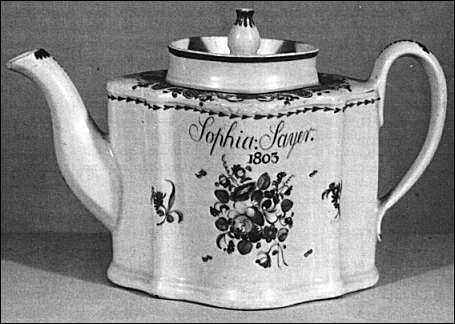
A New Hall porcelain teapot, of typical form
bearing the date 1803. 6 inches High.
In the Victoria & Albert Museum (Crown copyright)
The reader is referred to G E Stringer’s New Hall Porcelain (Art Trade Press Ltd., London, 1949) for a detailed history of the works and illustrations of typical specimens. A more recent work is D. Holgate’s New Hall Porcelain and its Imitators (Faber & Faber, London, 1971).
The works, after having been closed for a short time, were opened by William Ratcliffe, who for a few years made the commoner description of white and printed earthenware for ordinary home consumption.
In 1842, they passed into the hands of W. Hackwood & Son, who removed from their works near Joiner Square (later called the Eastwood Pottery); and in 1849, Mr. Hackwood senior having died, they were continued by his son, Thomas Hackwood. The goods were various descriptions of earthenware, principally for Continental markets, and bore the name HACKWOOD impressed.
In 1856, the works passed into the hands of Cockson & Harding, who manufactured the same kind of goods, using the mark C & H, LATE HACKWOOD impressed on the bottom. In 1862, Mr. Cockson having retired from the concern, the works were carried on by the remaining partners – the brothers W. & J. Harding who, besides an extensive trade with Holland and Italy in cream-coloured printed ware, produced druggists’ fittings as well as Egyptian black, Rockingham and tinted ware.
In 1869, Messrs. Harding gave up the business, when John Aynsley, china manufacturer of Longton, purchased the back portion of the works and let it to Thomas Booth & Sons.
The entire front of the New Hall works was purchased by Henry Hall, metal mounter of jugs, teapots, etc., so that the manufactory became divided into two distinct properties. The portion occupied by Messrs. Booth, having been burnt down, was rebuilt. Their productions were the usual classes of ordinary earthenware in printed, painted, enamelled, and gilt services; stoneware, in which a large variety of jugs and teapots were made; and jasper ware.
They were succeeded in their business in about 1870 by Ambrose Bevington & Co., who continued the manufacture to about 1890. From 1892 to 1899, Messrs. Plant & Gilmore were working the New Hall factory.
From 1900 to 1957, the New Hall Pottery Co. Ltd. produced a wide range of earthenware including many old patterns and styles.
1861 census
Westgate, Ipswich
Suffolk, England
| Name | age | Birthplace | Relationship | Occupation |
| Ambrose Bevington | 26 | Hanley, Staffordshire | Lodger | Earthenware manufacturer |
1871 census
5 Windmill Terrace, Hanley
Stoke on Trent, Staffordshire, England
| Name | age | Birthplace | Relationship | Occupation |
| Ambrose Bevington | 37 | Hanley, Staffordshire | Head | Decorator of China, employs 7 men, 17 women, 10 girls. |
| Margarette Bevington | 31 | Hanley, Staffordshire | Wife | |
| Ada Bevington | 7 | Hanley, Staffordshire | Daughter | scholar |
| Ethel Bevington | 5 | Hanley, Staffordshire | Daughter | scholar |
| Ernest Bevington | 2 | Hanley, Staffordshire | Son | |
| [unnamed] Bevington | 1m | Hanley, Staffordshire | Daughter | |
| Fanny Sadler | 17 | Hanley, Staffordshire | Servant | general servant |
| Mary Warrillow | 63 | Alnwick, Northumberland | Nurse | monthly nurse |
1881 census
Blythe Bridge,
Stone, Staffordshire, England
| Name | age | Birthplace | Relationship | Occupation |
| Ambrose Bevington | 44 | Hanley, Staffordshire | Head | Earthenware manufacturer |
| Ada Bevington | 17 | Brighton, Sussex | Daughter | |
| Ernest Bevington | 11 | Northwood, Staffordshire | Son | Scholar |
| Fanny Robinson | 23 | Staffordshire | Visitor | Dressmaker |
| Ann Aviland | 30 | Leek, Staffordshire | Servant | cook, domestic servant |
| Florence Sheldon | 16 | Consall Nr Leek, Staffordshire | Servant | housemaid, domestic servant |
The Bevington family of potters
The Bevington family were prolific potters in Hanley, Stoke-on-Trent, Staffordshire. Starting with the father Samuel (b.1808 d.1863), between them they owned or worked 12 pottery factories.
NOTE: dates are approximate and may overlap, sources include trade directories and so entries may be missing for some years. Also some of the works may have been shared with other potters – it was not uncommon for works to be sub-let.
Details of the Bevington family:
Details of the Pottery Works operated:
| WORKS OPERATED | Samuel (father) | Ambrose | John | James | Thomas |
| Swan Works, Elm Street | 1835-63 | 1863-69 # | |||
| Marsh Street | 1846-63 | 1863-67 | 1863-67 | ||
| 10-12 Brunswick Street | 1851-63 | 1865 $ | |||
| Burton Place | 1867-76 | 1867-76 1877-91 (on own) | |||
| Cannon Street | 1873-75 | 1873-75 | |||
| Cobden Works, High Street | 1881-85 | ||||
| King Street | 1884 | ||||
| Dresden Works, Birch Street | 1869-70 | ||||
| Clarence Street | 1874-79 | 1860-69 | |||
| Mayer Street | 1892 | ||||
| New Hall Works, Great York Street | 1870-92 | 1863-69 | |||
| Kensington Works, St. James Street | 1872-92 |
# John Bevington at the Elm Street Works – from 1866 passed into the hands of W. L. Evans & Co (the ‘& Co’ probably includes John Bevington). In 1867-69 Bevington is still recorded as having an interest in the Elm Street Works as “Bailey & Bevington”
$ John Bevington & Co recorded at the Brunswick Street Works in 1865. William L Evans was recorded at the Brunswick Street Works in 1869 & 70.
The census details for Richard & Henry
1861 census
36 Windmill Street, Wellington Parish, Hanley
Stoke upon Trent, Staffordshire, England
| Name | age | Birthplace | Relationship | Occupation |
| Richard Bevington | 34 | Hanley, Staffordshire | Head | China painter |
| Sarah Ann Bevington | 30 | Hanley, Staffordshire | Wife | China burnisher |
| Eliza Bevington | 13m | Hanley, Staffordshire | Daughter |
1861 census
Brunswick Street, Shelton, Hanley
Stoke upon Trent, Staffordshire, England
| Name | age | Birthplace | Relationship | Occupation |
| Henry Bevington | 22 | Stoke, Staffordshire | Lodger | Potter |
1871 census
5 Windmill Terrace, Hanley
Stoke on Trent, Staffordshire, England
| Name | age | Birthplace | Relationship | Occupation |
| Richard Bevington | 44 | Hanley, Staffordshire | Head | China Guilder |
| Sarah A Bevington | 40 | Hanley, Staffordshire | Wife | China burnisher |
| Eliza Bevington | 11 | Hanley, Staffordshire | Daughter | Scholar |
| George Bevington | 8 | Hanley, Staffordshire | Son | Scholar |
| Catherine Bevington | 3 | Hanley, Staffordshire | Daughter | |
| Richard J Bevington | 1 | Hanley, Staffordshire | Son |
1871 census
49 Market Street, Hanley
Stoke on Trent, Staffordshire, England
| Name | age | Birthplace | Relationship | Occupation |
| Henry Bevington | 32 | Hanley, Staffordshire | Head | China decorator |
| Charlotte Bevington | 26 | Hanley, Staffordshire | Wife | |
| Rose Bevington | 3 | Hanley, Staffordshire | Daughter | |
| Florence Bevington | 2 | Hanley, Staffordshire | Daughter | |
| Odo Bevington | 4m | Hanley, Staffordshire | Son | |
| Ann Goldstraw | 19 | Hanley, Staffordshire | Sister-in-Law | China guilder |
1881 census
5 Hall Fields, Hanley
Stoke upon Trent, Staffordshire, England
| Name | age | Birthplace | Relationship | Occupation |
| Richard Bevington | 55 | Hanley, Staffordshire | Head | Ch Guilder |
| Sarah Ann Bevington | 50 | Hanley, Staffordshire | Wife | |
| George Bevington | 18 | Hanley, Staffordshire | Son | Ch Guilder |
| Catherine Bevington | 14 | Hanley, Staffordshire | Daughter | scholar |
| Richard J Bevington | 11 | Hanley, Staffordshire | Son | scholar |
1881 census
49 John Street, Hanley
Stoke upon Trent, Staffordshire, England
| Name | age | Birthplace | Relationship | Occupation |
| Henry Bevington | 42 | Hanley, Staffordshire | Head | China guilder |
| Charlotte Bevington | 36 | Hanley, Staffordshire | Wife | China paintress |
| Rose Bevington |
| Hanley, Staffordshire | Daughter | |
| Florence Bevington |
| Hanley, Staffordshire | Daughter | |
| Odo Bevington |
| Hanley, Staffordshire | Son | |
| Ann Goldstraw |
| Hanley, Staffordshire | Sister-in-Law | China guilder |
Credits:
http://www.thepotteries.org/

